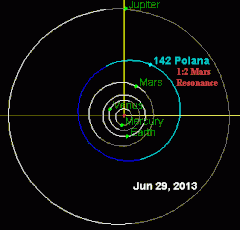142 Polana

Polana is in a 1:2 resonance with Mars
|
|
| Discovery | |
|---|---|
| Discovered by | Johann Palisa |
| Discovery date | 28 January 1875 |
| Designations | |
|
Named after
|
Pula |
| Asteroid belt | |
| Orbital characteristics | |
| Epoch 31 July 2016 (JD 2457600.5) | |
| Uncertainty parameter 0 | |
| Observation arc | 117.65 yr (42971 d) |
| Aphelion | 2.7444 AU (410.56 Gm) |
| Perihelion | 2.0934 AU (313.17 Gm) |
| 2.4189 AU (361.86 Gm) | |
| Eccentricity | 0.13457 |
| 3.76 yr (1374.1 d) | |
|
Average orbital speed
|
19.07 km/s |
| 140.92° | |
| 0° 15m 43.128s / day | |
| Inclination | 2.2379° |
| 291.27° | |
| 292.00° | |
| Earth MOID | 1.0855 AU (162.39 Gm) |
| Jupiter MOID | 2.24085 AU (335.226 Gm) |
| Jupiter Tisserand parameter | 3.501 |
| Physical characteristics | |
| Dimensions |
55.29±1.6 km 55.3 ± 1.6 |
| 9.764 h (0.4068 d) | |
|
Sidereal rotation period
|
9.764 hr |
|
0.0451±0.003 0.045 ± 0.003 |
|
| Temperature | ~179 K |
|
F/B B−V=0.621±0.022 U−B=0.236±0.035 |
|
| 10.27 | |
142 Polana is a very dark asteroid from the asteroid belt. It was discovered by Johann Palisa on January 28, 1875, and named after the city of Pola (now Pula, Croatia), home of the Austrian Naval Observatory where he made the discovery.
It is a major member of the eponymously named Polana family, which is a subgroup of the Nysa family. The asteroid has an estimated diameter of about 55.3 km and a low albedo of 0.045. It is orbiting at a distance of 2.419 times the separation of the Earth from the Sun, with an orbital period of 3.76 years and an eccentricity of 0.14.
In the Tholen classification scheme, Polana is a primitive carbonaceous asteroid of type F, which is a subdivision of more common C-type. Under the SMASS classification taxonomy, Polana is listed as a B-type asteroid; a group that combines both the Tholen B and F types. The spectrum of this object suggests the presence of magnetite (Fe3O4), which gives it the spectrally blue coloration that is a characteristic of this SMASS class.
Polana is in a 1:2 orbital resonance with Mars, meaning that Polana orbits the Sun once for every two orbits that Mars completes. This resonance helps protect the asteroid from orbital erosion: the orbital eccentricities of the resonant asteroids are clearly greater than the non-resonant asteroids. There is a peak in the number of asteroids located at 2.419 AU from the Sun. In spite of strong perturbations caused by the passing of both Jupiter and Mars, the 1:2 Mars resonance brings about stability for billions of years. There are up to 1,500 asteroids in this resonance, and the resonance between Polana and Mars will strengthen over the next million years due to Polana transitioning into a strong libration period with Mars.
...
Wikipedia
